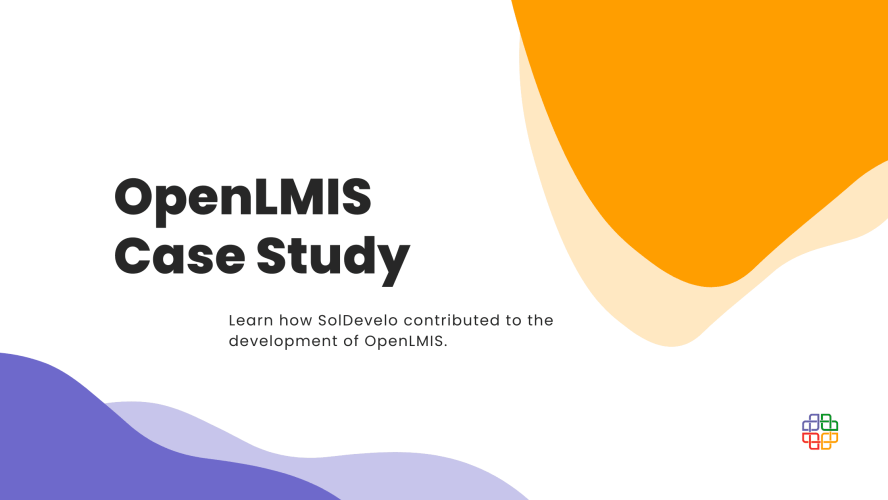The world linked by a unified core codebase that accelerates society’s development and improves cooperation in crucial business sectors? Seems like a sci-fi dream? Well, yes, probably a little bit. However, the project by OpenLMIS, which we took an active part in, indicates that this fantasy is not so far-fetched at all.
OpenLMIS

In case you haven’t heard yet, OpenLMIS is an initiative supported by an international community of donors, partners, implementers, and developers who all share a common vision. They dream of a world where all countries have the logistics data enabling the effective management of their supply chain. All of this in order to save lives.
Sounds good, right? That is why they have designed and developed an Open Logistics Management and Information System (OpenLMIS) tool. Its main aim is to improve health commodity distribution in low and middle-income countries.
Our Input
So far, OpenLMIS has been successfully deployed in nine African countries, such as Angola, Benin, Côte d’Ivoire, Guinea, Malawi, Mozambique, Tanzania, Zambia, and Zanzibar (see product’s roadmap). In all those places it helps to administer logistics processes for over 11,000 health facilities. SolDevelo worked on OpenLMIS implementations in Angola and Malawi. Together with VillageReach, a non-profit global health innovator with extensive expertise in health supply chains and logistics, we created a more flexible and extensible core software architecture for OpenLMIS and contributed to the development of localization features and customization appropriate for each country’s context.
The Challenges We Had to Meet
However, the beginnings, as always, were not as bright and promising. OpenLMIS, being a large and diversified software project, was initially subjected to many risks and uncertainties. As new installations were developed and implemented by the community, it led to a situation where every country was using a slightly different version of the tool. Soon, as could have been expected, a code fork occurred. What it means is that the core code was diverged in different directions and the whole community was lacking a common plan on how to align the various implemented OpenLMIS versions. As a result, teams’ priorities, problems, and measures for success differed as well.
In order to address code-forking, the OpenLMIS community agreed to work towards a common master branch. The idea was that all the countries would be sharing one global, open-source codebase in such a way that all improvements and contributions (such as new features) made by one country could be used by anyone in the community.
The GAP Project
In support of the OpenLMIS unification idea, the United States Agency for International Development (USAID) and Digital Square funded the GAP Project. The initiative, planned for the period of 1 year, was perfectly lined up with the community’s “shared investment, shared benefit” philosophy. It was planned as a solution for reducing the code gap for the OpenLMIS v2. deployments in Tanzania and Zambia, with the end goal of creating an upgrade path to OpenLMIS v 3.0.
After the so-called gap analysis and identification of feature incompatibilities between the different versions of the software, the GAP project was commenced. SolDevelo, together with 3 other organizations (John Snow Inc., Ona, and VillageReach), put a collaborative effort into bug fixing and adding new features to bridge the identified gap. Thanks to our skilled development team that can boast about their broad expertise in the complex tools, we extended the system where it was necessary, to meet country-specific needs. At the same time, we did our best to maintain the ability to receive OpenLMIS core software updates.
OpenLMIS v 3.0
SolDevelo greatly contributed to laying the groundwork for future OpenLMIS upgrades to version 3.x in Tanzania and Zambia, delivering the assigned tasks within the set timeframe and budget. The GAP project resulted in completing 22 of all the features identified in the gap analysis. They included the conversion of a requisition to order and subsequent transfer to a warehouse system, integration with the OpenHIE mCSD facility registry, and the recreation of many of the original eLMIS reports in the new OpenLMIS reporting system.
Thanks to new features implementation, SolDevelo helped to re-invent the OpenLMIS architecture so that it has a global shared benefit. Now it is a powerful and flexible product that exhibits interoperability and supports customizations and extensions. Additionally, the GAP Project turned out to be an important and beneficial transition in the whole OpenLMIS initiative. Thanks to it, the community realizes the importance of the tool unification and is encouraged to always upgrade to its latest version.
Read more!
Curious to find out more? Check here for further information on SolDevelo and OpenLMIS. We also recommend our blog posts on how OpenLMIS is bringing real help to the people of Malawi: OpenLMIS 3.0: Providing Health Supplies For Those In Need and OpenLMIS 3.0 In Malawi: Understand The Existing Ecosystem.




